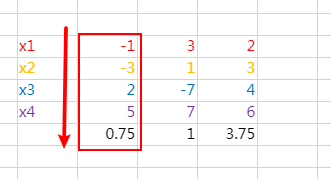In this tutorial, we will discuss how the mean and variance computed in batch normalization, which is very usefult to understand batch normalization.
For example:
There is a batch, the shape of it is (64, 200). There are three ways to compute the mean (\(\mu\)) and variance \(\sigma\) .
Way 1:
Compute the mean (\(\mu\)) and variance \(\sigma\) on 12800 data. You will get two scalar.

Way 2:
Compuate the mean (\(\mu\)) and variance \(\sigma\) on axis = 1. You will get two 1*64 vectors.

Way 3:
Compuate the mean (\(\mu\)) and variance \(\sigma\) on axis = 0. You will get two 1*200 vectors.

If we will normalize the data on axis = 1, which way is used in batch normalization?
The answer is way 3.
We will use an example to show you this answer.
Look at code example below:
import os
import numpy as np
import tensorflow as tf
cap_map = tf.convert_to_tensor(np.array([[-1,3,2], [-3,1,3],[2,-7,4],[5,7, 6]], dtype = float), dtype = tf.float32)
def norm(xs):
fc_mean, fc_var = tf.nn.moments(
xs,
axes = 0,
keep_dims=True
)
epsilon =0.001
xs = tf.nn.batch_normalization(xs, fc_mean, fc_var, 0.0, 1.0, epsilon)
return xs
n1= tf.layers.batch_normalization(cap_map, axis = 1, training=True, scale=False)
n2 = norm(cap_map)
init = tf.initialize_all_variables()
with tf.Session() as sess:
sess.run(init)
print (sess.run(n1))
print (sess.run(n2))cap_map is a 4*3 tensor, which means the batch size = 4.
We will normalize the data on axis = 1.
tf.layers.batch_normalization() will use batch normalization to normalize the data.
n1 is:
[[-0.57731885 0.39222473 -1.1829456 ] [-1.2371118 0. -0.5069766 ] [ 0.4123706 -1.568899 0.16899228] [ 1.40206 1.1766742 1.5209303 ]]
tf.nn.batch_normalization() function normalize the data based on tensor mean and variance. In this example, we will calculate them on axis = 0.
Run this code, we can find n2 is:
[[-0.57731885 0.39222473 -1.1829456 ] [-1.2371118 0. -0.5069766 ] [ 0.4123706 -1.568899 0.16899228] [ 1.40206 1.1766742 1.5209303 ]]
n1 = n2
It means the way 3 is implemented in batch normalization.